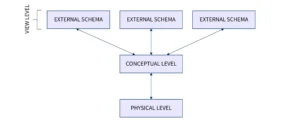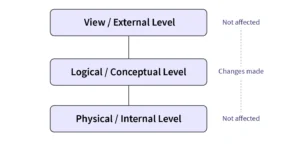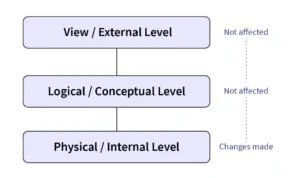Data Abstraction & Data Independence in DBMS
In a Database Management System (DBMS), managing complexity and hiding unnecessary details is critical. Two key concepts that help achieve this are data abstraction and data independence. Together, they simplify how users interact with databases and make systems more adaptable to change.
1. Data Abstraction
Data abstraction refers to the process of hiding the details of how data is stored and maintained while presenting users with only the necessary information. The idea is to provide different users with appropriate views of the database without showing all internal complexity.
Data in a DBMS is abstracted across three levels:
- External Level: Users see only the part of the database they need. For example, a student sees only their grades, not the entire database.
- Conceptual Level: Describes what data is stored and the relationships among them. It hides physical storage details.
- Internal Level: Deals with how data is physically stored, such as files, indexing, or disk blocks.

This layered abstraction ensures that users and application programs interact with the database without needing to know its internal structure.
2. Data Independence
Data independence is the ability to change the schema (structure) at one level of a database without affecting the schema at the next higher level. It is a major benefit of the three-level architecture.
There are two types:
a. Logical Data Independence
- Definition: The ability to change the conceptual schema without having to alter the external views or application programs.
- Example: Adding a new attribute to a table or creating a new relationship between entities should not require changes in how end-users view the data.
- Importance: Supports flexibility in business logic, allowing database design to evolve as requirements change without affecting user interfaces.
b. Physical Data Independence
- Definition: The ability to change the internal schema (how data is stored) without changing the conceptual schema.
- Example: Changing from one file organization method to another or altering indexing strategies should not affect the logical design of the database.
- Importance: Allows optimization of storage and performance without disrupting application functionality.
Conclusion
Data abstraction and data independence are core principles of DBMS that help manage complexity, enhance flexibility, and ensure stability in database systems. They make it possible for developers, administrators, and end-users to work efficiently at their own level of interaction without needing to understand every detail of the database structure.

